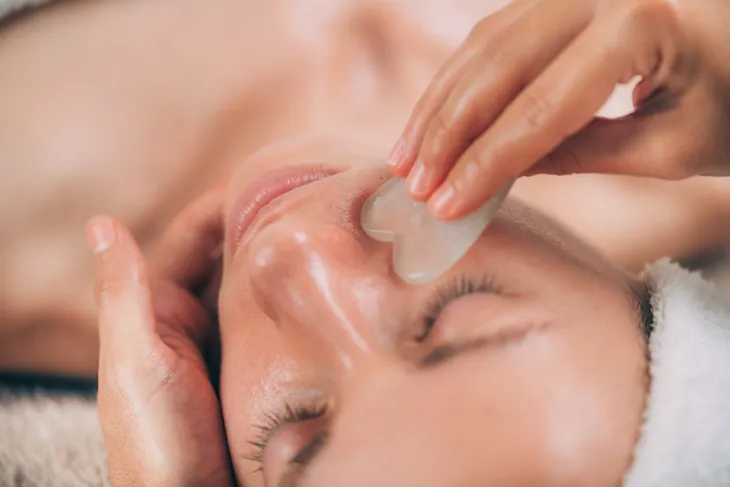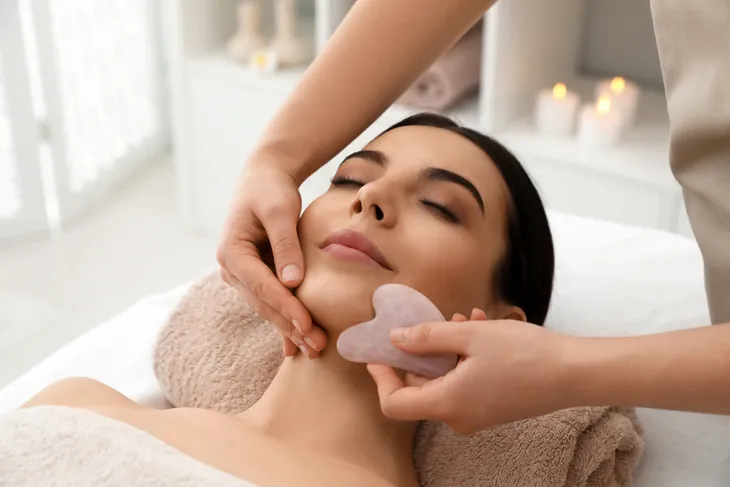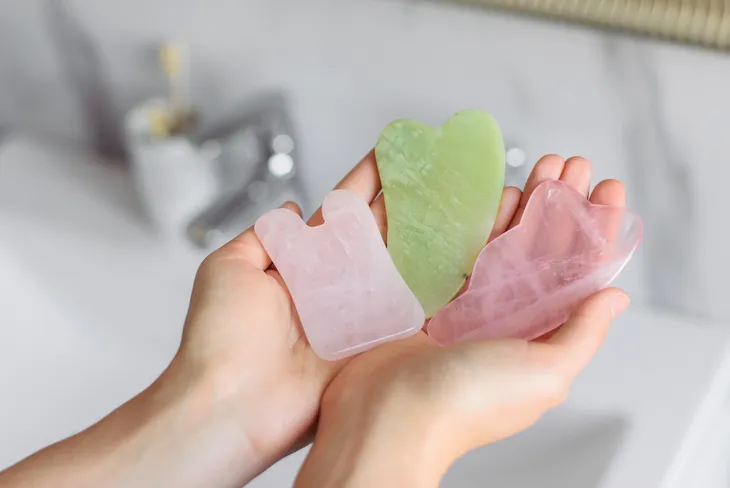- Gua sha is a traditional and natural ancient Chinese healing technique.
- The technique involves scraping your skin with a gua massage tool to improve circulation.
- Gua sha can help relieve tension, and reduce puffiness and inflammation in the skin but it may also offer many other benefits too.
If you like skincare and wellness trends, odds are you’ve heard of gua sha, also known as skin scraping therapy. It may seem like a hot new trend but it’s actually a form of traditional Chinese medicine that has been practiced for hundreds of years.
While gua sha is often touted for its benefits of sculpting and toning the skin, it may also offer other benefits too. Follow along as we uncover everything you need to know about gua sha, including what it is, the potential benefits and risks, as well as how you can do it at home.
What Is Gua Sha?
Gua sha is a traditional and natural ancient Chinese healing technique. It involves scraping your skin with an instrument with smooth edges to improve circulation. Some believe it may also help with health problems like chronic pain.
Healthline explains. “Gua sha is intended to address stagnant energy, called chi, in the body that practitioners believe may be responsible for inflammation.” The idea is that by rubbing the skin’s surface, you can help break up energy and in turn reduce inflammation and encourage healing.
How Does It Work?
During gua sha, a technician will scrape your skin with short or long strokes. The goal is to “stimulate microcirculation of the soft tissue, which increases blood flow,” explains Healthline. The strokes are done with a smooth-edge instrument, known as a gua massage tool.
First, the technician will apply massage oil to your skin and then they will use the gua massage tool to repeatedly scrape your skin using a downward motion. Medical News Today explains that the scraping motion causes bleeding (known as petechiae) within the middle layer of your skin. This process forces the skin to recover naturally, resulting in improved immune surveillance in the skin.
Gua sha is most commonly performed on the neck, arms, legs, back, and buttocks. A gentler version is also often used on the face. Technicians typically start with mild pressure and may gradually increase the intensity to find out how much you can handle.
The Potential Benefits of Gua Sha
Gua sha is known to offer many benefits. When used on the face, it may help relieve tension, and reduce puffiness and inflammation. It may even help reduce sinus pressure, according to the Cleveland Clinic.
Gua sha may also offer full-body benefits from reducing aches and pains to benefitting conditions like perimenopausal syndrome. Let’s take a look at what some of these other benefits entail next.
Benefit: Release Muscle Tension
Gua sha can be used on the body and it may help relieve muscle tension. The Cleveland Clinic explains that when you have a muscle knot, the gua sha tool should be scraped across the knot, working perpendicular to the muscle fibers “so you can break up all of the adhesions.”
Once the muscle loosens, you’ll want to scrape in the direction of the muscle fibers to help lengthen and correct the direction. It’s important to not start in this direction as it can make the tissues tighter.
Benefit: Lymphatic Drainage
Gua sha may also benefit your lymphatic system, which circulates lymph fluid to your muscles. According to Harper Bazaar, gua sha can be particularly beneficial for lymphatic drainage in the face because the muscles in the face aren’t used as often as other muscles in your body.
Gua sha uses intentional movements during the facial massage to “move the lymph through the system,” explains the source. This may encourage a more toned and sculpted appearance.
Benefit: Migraine Relief
Migraine headaches can be debilitating. Luckily some medications can provide relief. But researchers are also looking into how gua sha may be able to help too.
One study examined a 72-year-old woman who suffered from chronic headaches. During the study, the woman received gua sha over 14 days and found that her headaches greatly improved. While these results are promising, more research is still needed.
Benefit: Neck Pain Relief
Gua sha may be able to help relieve neck pain. One study examined 48 individuals with chronic neck pain. During the study, the individuals were split into two groups. One group was given gua sha and the control group was given a local thermal heat pad to help treat the neck pain.
After 1-week, individuals in the gua sha group experienced significant improvement compared to the control group, indicating that gua sha has short-term benefits for chronic neck pain. The long-term benefits still need to be studied.
Benefit: Improve Perimenopausal Symptoms
Perimenopause is the transitional period before menopause. During this stage, levels of estrogen decrease which may result in symptoms like irregular periods, hot flashes, and fatigue. While these symptoms can be unpleasant, researchers are looking into how gua sha can help.
One study examined a group of 80 women with perimenopausal symptoms and divided them into two groups. The intervention group received 15-minute gua sha treatments once a week with conventional therapy. The control group only received conventional therapy. After the 8-week study, the intervention group reported greater reductions in symptoms (such as hot flashes, insomnia, nervousness, headache, and fatigue) compared to the control group. More research is still needed but preliminary results suggest gua sha may be a safe and effective treatment for perimenopausal syndrome.
Potential Risks and Side Effects
Gua sha is a safe natural healing remedy, however, there are some small side effects and potential risks to be aware of. Healthline points out that since gua sha involves scraping and rubbing of the skin, tiny blood vessels (called capillaries) can burst near the surface of your skin, resulting in minor bruising or bleeding.
Bruising typically goes away within a couple of days. However, if bleeding occurs there is a risk of transferring blood-borne illnesses. This is why tools must be disinfected after each treatment and another reason why you must receive gua sha from a trained and reputable professional. The source also notes that individuals who have a blood clotting disorder or are taking blood thinners should not receive gua sha. You should also avoid it if you’ve had surgery within the last 6-weeks.
At-Home vs. Professional Treatments
Unlike other treatments, such as microneedling, gua sha can be done at home, especially treatments for the face. However, Byrdie points out that if you’re new to gua sha, you should really see a professional first.
A trained professional can show you the proper technique to not only help you achieve better results but also to ensure you’re doing it safely. However, the best results will likely be achieved from a trained professional but you can still do it at home in-between appointments.
How to Do Gua Sha At Home
Gua sha can be an effective at-home treatment if done correctly. It’s very important to follow directions from a trained professional and don’t make up your own technique. Investing in a good gua sha tool can also help.
According to Brydie, to start an at-home facial treatment you’ll want to first apply face oil or serum. Then, “gently sweep the stone up the neck working your way toward the hairline, focusing on the cheekbones and jaw,” explains the source. This movement helps drain fluid downward and promotes circulation with the goal of toning and sculpting the skin. The source also notes that gentle pressure is all you need to achieve results.
How Often Should You Gua Sha?
Gua sha can be done often, however, the frequency will depend on a few factors, such as your skin type as well as your skin’s tolerance. Once you become more comfortable with the technique you can aim to do it two to three times per week, says Byrdie.
Over time, you can start doing gua sha daily using gentle pressure. Treatments should only last 3- to 5-minutes. Also, pay close attention to your skin and see how it reacts to each treatment. Talk to a professional if you’re not seeing the results you want or if you need further guidance.
How to Choose the Right Tools
Since gua sha is so popular, it’s easy to find tools online and at many stores. But it’s important to choose the right one for you. Licensed aesthetician, Ali Tobia, tells Byrdie that you should look for a tool that has the right curvature to fit the angles of your face. Tools that have more than one angle and curve are better as they provide you with more options.
While the type of stone isn’t necessarily as important as the shape, you may want to look for jade or amethyst for facial techniques. These types of stones are naturally cooling which can help soothe your skin and “counteract the warming effect of the technique,” explains the source.
















